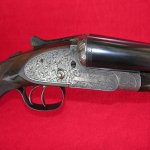It has been a while since I posted anything in this thread, and I recently acquired another pinfire, so why not?
The gun is signed Robert Ringer, and, like for most guns of the period, there is always interesting history associated with it.
Born in 1821, Robert Ringer began making guns under his own name in 1852 in Watton, near Thetford, in the rural county of Norfolk in Britain. He appears to have taken over the premises of William Burton, a gunmaker who started the business in 1839. Prior to 1852 Ringer was a journeyman gunmaker in the market town of Swaffham, working for either William Parson or Abigail Sutton. Where he completed his apprenticeship is not recorded, but it may well have been with Burton, Parson, or James Sutton. Ringer must have been successful in Watton, as he was able to open premises in Norwich in 1868, on Great Orford Street beside Norwich Castle, closing the Watton premises shortly afterwards. Around this time he employed one man and one boy, a fairly typical arrangement for a provincial gunmaker.
Norwich is the county town of Norfolk, established as a city in the 10th century, and from the 11th century onwards the second largest city in Britain after London. A thriving commercial centre into Victorian times, Norwich was built on the wool and textile trade, and as a gateway to mainland Europe (before the rail line established in 1845, it was said to have been quicker to travel to Amsterdam than to London). The county was also very good shooting country, for partridge, and later for pheasant – many storied shooting estates were located in the county, where by the middle of the 19th century, over a hundred Norfolk families owned estates greater than 2,000 acres in size.
Norwich was therefore a good location for a talented gunmaker, and in 1868 the pinfire game gun still ruled. In that year there were four other Norwich gunmakers in operation, with the best-known being George Jeffries
(in business from 1841 to 1899, Jeffries obtained in 1860 patent no. 1900 for a turnover tool which finally improved the performance of the pinfire cartridge to equal the muzzle-loader; this invention was overshadowed by James Purdey’s patent no. 302 of 1861, a much better turnover tool). The other three Norwich gunmakers, Robert Norton Dale, Robert John Howard, and John Ottway, were short-lived, open only in that year – competition was too great, I suppose. Like Jeffries, the Ringer business survived until around 1890, and would have turned out percussion guns, pinfires, and centrefires, in due course.
The gun today is a 12-bore double-bite screw grip rotary-underlever, serial number 796, signed
“Robert Ringer Gt Orford St Norwich” on the top rib. The 30” damascus barrels have London proofs, and the thin fences and lack of a radius between the action bar and the breech face are consistent with an earlier design, as might be found on provincial guns. The Great Orford Street address means its manufacture cannot be earlier than 1868, and a lack of records and surviving Ringer guns makes it difficult to date precisely – but I’m guessing 1868-1869, as by 1870 few pinfires were being built in Britain, and well-to-do Norwich customers would have followed the London trends. It is a well-made gun, with signed back-action locks, an elongated top strap, rounded dolphin-headed hammers, a ring-tipped underlever, good foliate scroll engraving, and a raised clip on the trigger guard bow. The well-figured stock suffered a catastrophic break at one point, and the period repair at the wrist kept it in the shooting field. It is a very trim and slim gun, light for a pinfire 12-bore at 6 lb 13 oz, and the bores are lightly pitted. The stock escutcheon has the letters
“LHS” in script, unfortunately not enough to trace its ownership. I would be surprised if Robert Ringer sold more than twenty pinfire game guns from his Norwich address, so it is good fortune that this one survived, though somewhat patched up.
















































